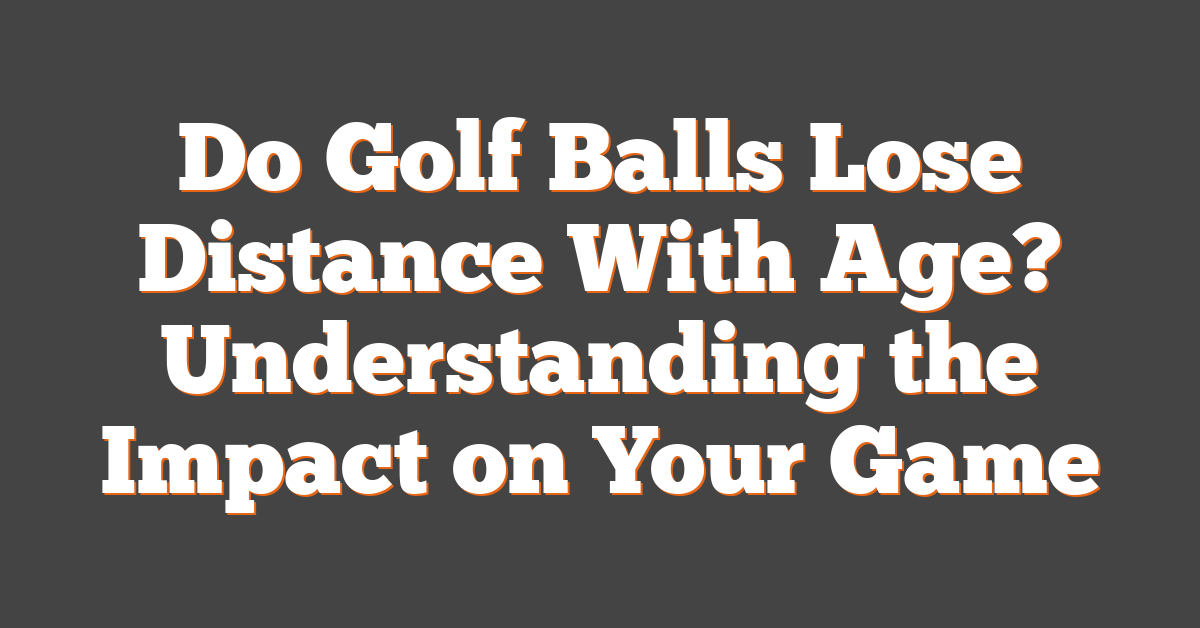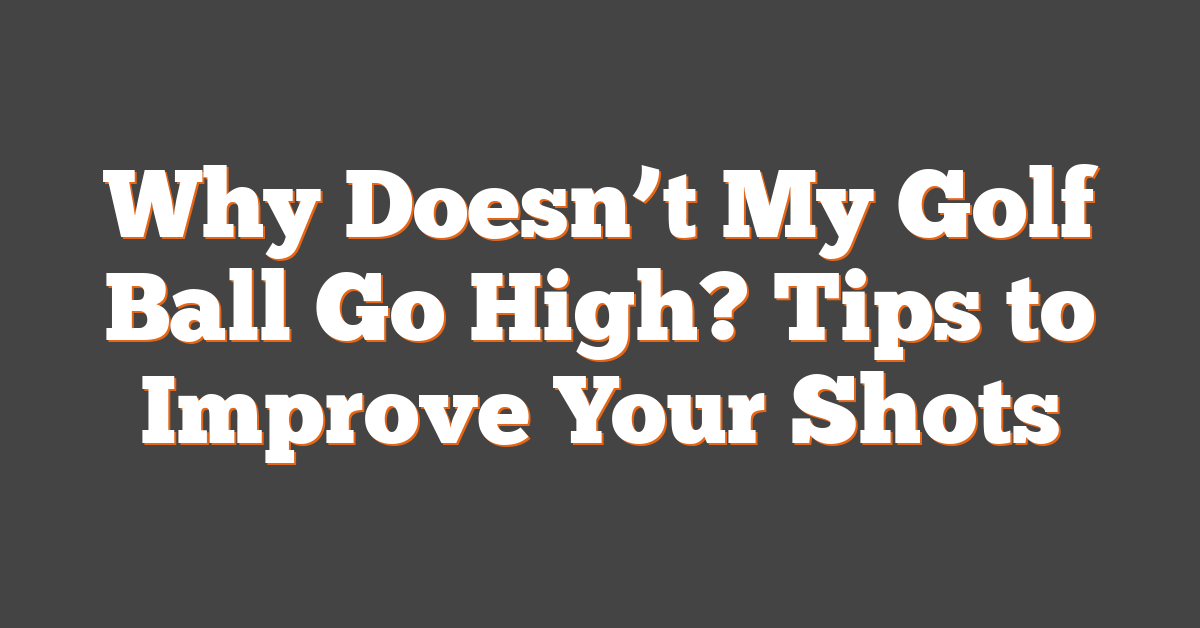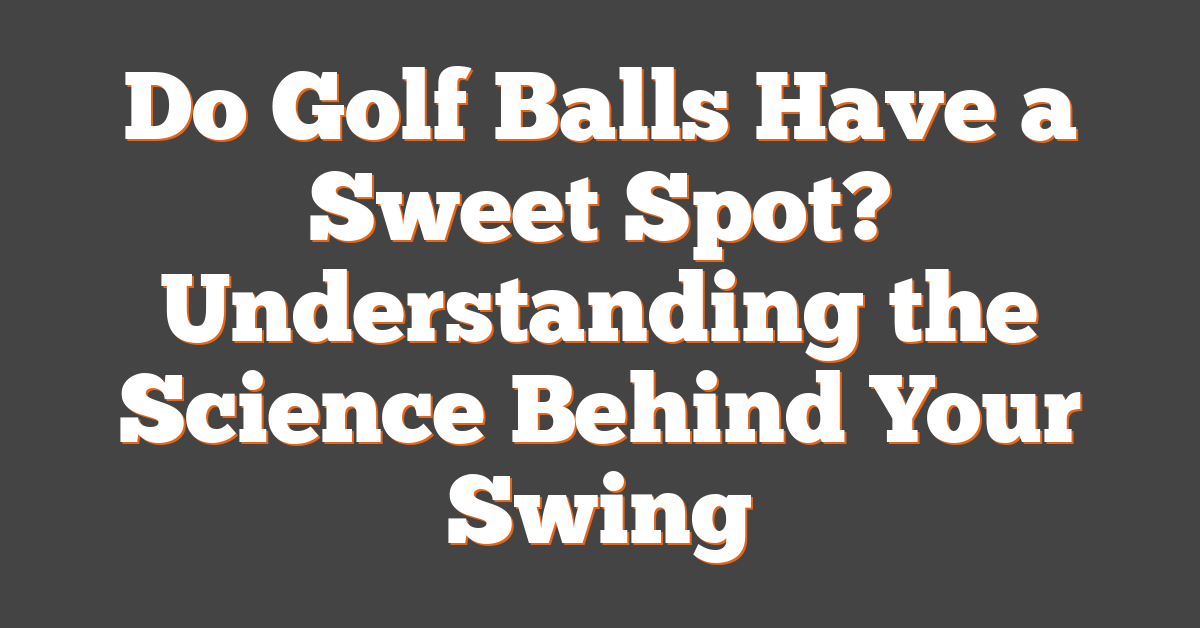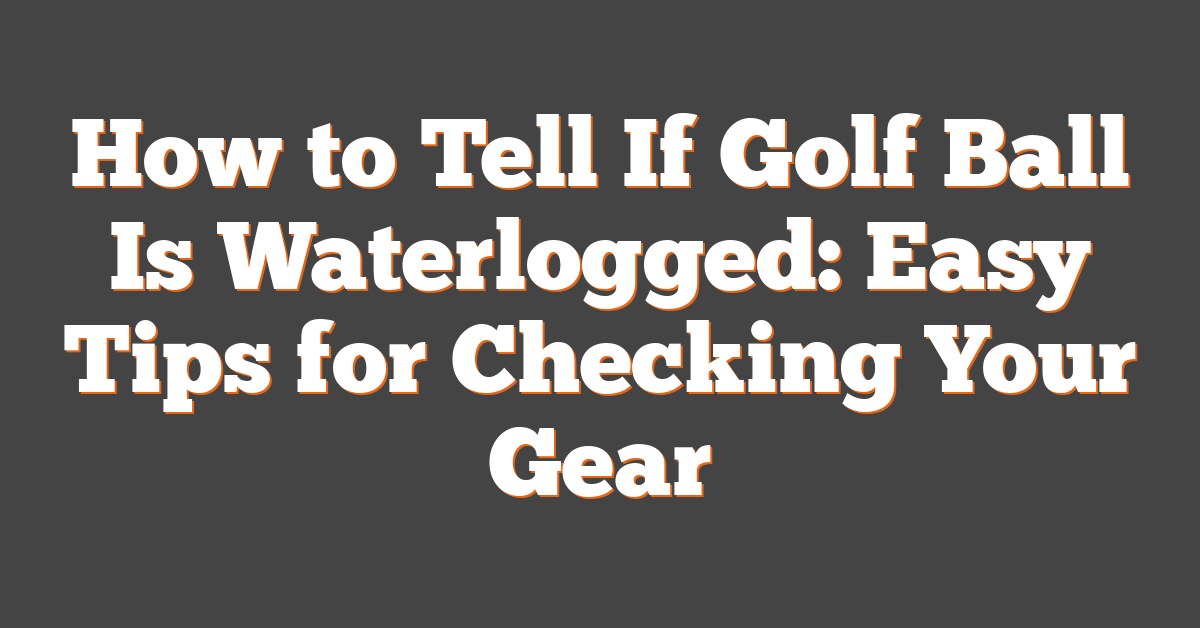When it comes to my golf game, I’ve often wondered whether the age of my golf balls affects their performance on the course. The good news is that golf balls can last for several years without a significant loss in distance, especially if they’re stored properly.
Understanding the effects of age on golf balls can help me make better choices and keep my game sharp.
As I’ve explored this topic, I found that the type of golf ball matters, too. Two-piece balls can last up to a decade without losing much distance, while three-piece balls might start to decline after just a few years. This information can really help me decide when to replace my old favorites.
With all the factors at play, including the core’s condition and how I take care of my equipment, I’m eager to share what I’ve learned.
Whether you’re a seasoned golfer or just starting out, knowing how age impacts golf balls might change the way you think about your game.
The Impact of Age on Golf Ball Performance
When it comes to golf balls, age can play a significant role in how well they perform. I have found that understanding the aging process helps me make better decisions about when to replace my golf balls. Here are some key factors to consider regarding durability and the physical changes that occur over time.
Aging Process and Golf Ball Durability
Golf balls typically have a shelf life of around 5 to 10 years, depending on storage conditions. If kept in a cool, dry place, they can last longer.
Over time, the materials used, like rubber and other polymers, can break down. The core of the ball may lose its elasticity, affecting its bounce and distance.
Balls that have been played frequently will show signs of wear sooner than those kept as backups.
It’s important to check the condition of your golf balls regularly. If they are cracked or feel hard to the touch, they may not perform as well.
Physical Changes in Golf Balls Over Time
As golf balls age, they undergo notable physical changes. The core, which is vital for compression, may become less elastic due to repeated impacts. This hardening can lead to a reduction in distance.
Additionally, the outer cover can get scuffed or scratched, affecting aerodynamics. Poor storage can also lead to moisture damage, which impacts performance.
Factors Affecting Golf Ball Distance with Age
As golf balls age, various factors can influence their distance and performance. I find it interesting to see how compression, aerodynamics, and storage play significant roles in this process.
Decrease in Compression and Ball Speed
One of the main issues with old golf balls is the decrease in compression. Compression is how much a golf ball deforms when struck.
Over time, the core can harden, reducing its ability to compress effectively during impact. This change leads to a loss of ball speed. When a ball can’t compress properly, it doesn’t spring back as quickly. Consequently, the distance it travels can decrease significantly.
« What’s the Farthest Golf Ball Ever Hit? Discover the Record-Breaking Distance!
What Golf Ball Spins the Most for Improved Control and Performance »
It’s important to check the condition of your golf balls, especially if they’re older. Harder balls often mean less fun on the course and shorter drives.
Alterations in Dimples and Aerodynamics
The dimples on a golf ball play a vital role in its aerodynamics. They help to create lift and reduce drag.
With age, these dimples can wear down or become damaged. When this happens, the ball may not cut through the air as effectively. A worn ball may not maintain its flight path, leading to decreased distance. I’ve seen how a scuffed or dirty ball can lead to disappointing shots.
To maintain ball performance, it’s best to keep your golf balls clean and check for damage regularly.
Impact of Storage Conditions on Golf Ball Longevity
How I store my golf balls can also affect their lifespan and performance.
Golf balls should be kept in a cool, dry place. Excessive heat or humidity can break down the materials inside, leading to a decline in performance.
If I leave my balls in a hot car or a damp basement, I may find they don’t travel as far as they used to. The shelf life of a golf ball can range from a few years to much longer, depending on storage conditions.
Perceived Distance Loss in Used Golf Balls
When it comes to used golf balls, many golfers wonder how much distance they actually lose compared to new ones. I’m going to explore the differences between new and old golf balls and share some real experiences from fellow golfers regarding their use of aged balls.
Differences Between New and Used Golf Balls
New golf balls are designed to provide optimal performance, including consistent flight and distance. When I buy a new ball, I appreciate the feel and the control it offers. These balls have a longer shelf life and maintain their intended compression.
On the other hand, used golf balls often show signs of wear and tear. Scuff marks and visible damage can alter their performance. Even minor impacts can affect aerodynamics, and these changes can lead to a noticeable loss of distance.
For example, balls that are 10 years old, even if stored correctly, can lose about 0.5 to 1 percent of their initial velocity. This translates to possibly losing a few yards on each shot.
Golfers’ Experiences with Old Golf Balls
My experiences are shared by many who play with old golf balls. While some golfers accept minor distance loss, others feel it affects their game significantly.
Many of my friends have noticed that using a used ball can make their shots feel less powerful.
Interestingly, the perception of distance loss often comes from the feel of the ball during play. When I hit a used ball, it sometimes lacks the crisp feel of a new one. This can give the impression that I am not hitting it as far.
For golfers on a budget, it’s worth trying used balls, but always check for visible damage before hitting the course.
Environmental Impact on Golf Ball Flight
Understanding how the environment affects golf ball performance helps me make better choices on the course. A few key factors include temperature, humidity, and wind, all of which can influence how far and straight my golf ball travels.
Temperature, Humidity, and Wind Effects
Temperature plays an essential role in golf ball flight. When it’s warm, the air is less dense, allowing golf balls to travel farther. In contrast, cold weather makes the air denser, which may reduce distance. A temperature increase of about 10 degrees Fahrenheit usually adds about a yard of distance to a golf shot.
Humidity also affects ball flight. Higher humidity can help balls travel further because moist air is less dense.
Wind can be a game-changer too. A strong tailwind can push a ball further, while a headwind can hold it back. Understanding these effects helps me adjust my game strategy.
Golf Ball Performance in Various Weather Conditions
In freezing temperatures, golf balls can lose flexibility, making them harder and less effective. If my balls are stored in extreme cold, they may not perform well when I finally play. It’s best to keep them at a stable room temperature.
Rainy weather can create slick conditions. Wet grass may slow the ball down but also keeps it from bouncing too far. I pay close attention to these factors so I can select the right club and adjust my swing. Each environmental element can make a big difference, from a light breeze to a chilling winter day.
Maximizing Performance with Golf Ball Care
Taking care of my golf balls is essential for getting the best performance on the course. Proper storage and regular maintenance can extend their lifespan, ensuring I get the most out of each ball. Here’s how I do it.
Best Practices for Golf Ball Storage
Storing golf balls correctly is key to maintaining their performance. I always keep my balls in a cool, dry place. Room temperature is ideal, as high heat can affect the materials inside.
I avoid leaving them in my car or areas with extreme temperatures. Storing them in a sturdy container or original packaging prevents unwanted damage. I also keep them away from moisture, which can cause deterioration.
For long-term storage, check the balls every few months to make sure they are in good condition. Keeping them clean and dust-free helps maintain their performance level.
Extending the Life of Your Golf Balls
To ensure my golf balls last as long as possible, I follow some practical tips.
After each round, I clean my balls with mild soap and water to remove dirt and grass, which can affect performance.
I inspect them for any scuffs or cuts that could impact how they fly. If I find damage, I decide whether to continue using them or switch to a fresher ball.
Using older balls for practice is a good way to save newer ones for play. I also avoid putting them through extremes, like hitting off hard surfaces or leaving them in wet conditions.
By being mindful of how I care for my balls, I can really enhance their lifespan and performance.
The Role of Equipment in Golfing Success
Equipment plays a vital role in how well I perform on the golf course. From the type of golf ball I choose to the clubs I use, each piece of gear can significantly affect my game. Here are two crucial aspects of equipment that I always consider.
Choosing the Right Golf Ball for Your Game
Selecting the right golf ball is one of the most important choices I make. Different balls have various construction materials, which can impact distance, spin, and control.
For instance, a soft ball can provide more spin around the greens, while a harder ball might offer more distance off the tee.
When shopping for golf balls, I often look for those that match my playing style. Some balls perform better in wet conditions, while others excel on dry surfaces.
I also consider my skill level. As a beginner, I need a durable ball that can withstand misuse. As I improve, I may switch to a ball that offers more performance features.
Golf Clubs and Their Influence on Ball Trajectory and Spin
The clubs I use greatly influence my shots. Each club has a specific role in my game, affecting the trajectory and spin of the ball.
The driver, for instance, is designed for long-distance shots, while my irons are better for accuracy and approach shots. The loft and shaft flexibility also play a role in how high or low the ball flies.
Using the right club helps me achieve my desired shot shape. I also pay attention to what brand and model suits my swing style. Properly fitted clubs can help me improve my consistency and control, making my game more enjoyable and effective.
Practical Insights for Different Types of Golfers
Choosing the right golf ball can impact performance for golfers at all levels. Understanding the differences based on experience and skill can help me make better choices when selecting a ball.
What Beginners Need to Know About Golf Ball Selection
For beginners, starting with high-quality golf balls is key. I suggest looking for balls designed specifically for beginners, which tend to offer more forgiveness and distance.
A soft feel can help beginners with control around the greens, which makes it easier to learn short game skills. Many beginner-friendly balls have a two-piece construction that provides good distance and accuracy.
It’s also smart to buy a dozen golf balls. I recommend getting a mix of brands and types. That way, I can see which ball fits my playing style best.
Remember, price isn’t everything; sometimes, spending a bit more on a decent ball can improve my game.
Considerations for Professional Golfers and Longest Hitters
Professional golfers and longest hitters have unique needs when selecting a golf ball. I find that these players often favor multi-layer balls. These provide better spin and control for their advanced skills.
The compression rating of a ball plays a crucial role too. High-compression balls can offer more distance for players with faster swing speeds. This is essential to maximize performance, especially off the tee.
Another important point is the ball’s aerodynamics. The design can greatly influence distance.
Pro golfers can assess how different dimples affect flight patterns and choose balls that complement their swings. Testing different balls during practice rounds can lead to finding the perfect match that enhances distance and control on the course.
Techniques to Optimize Golf Ball Usage on the Course
I’ve learned that using the right techniques can make a big difference in how my golf balls perform throughout a round. By focusing on various aspects of my game, I can optimize both performance and distance. Here are some key strategies I’ve found helpful.
Strategies for Teeing Off
When I tee off, choosing the right golf ball is essential. I prefer using a premium ball for the first drive because it provides better distance and control. The initial tee shot sets the tone for the hole, so I make sure to tee the ball high enough to promote a clean strike.
I also pay attention to my swing mechanics. Maintaining a smooth, controlled swing usually helps maximize my driving distance. Using the right tee height can aid in achieving the optimal launch angle, enhancing distance. Additionally, consistently using the same type of ball helps me understand its behavior off the tee.
Navigating the Fairways and Greens
On the fairways, I keep my focus on accuracy and control. I tend to use a softer ball for better feel when hitting approach shots. This allows me to gauge how the ball reacts to different terrains.
When I reach the greens, I assess the surface conditions. If it’s wet, I adjust my approach because the ball might not roll as much. I also find that a ball with good spin properties helps me better control the distance when I chip onto the green.
Specialized Shots: Chipping and Putting
Chipping and putting require precision. I always choose a ball that offers good feel for these short shots. For chips, using a ball with a softer cover helps me better control the roll and distance after landing.
During putting, I focus on the initial roll of the ball. A solid, well-constructed ball rolls smoothly across the green. I ensure my ball is clean before each putt to avoid any interference with its path. By choosing thoughtfully, I can enhance my accuracy, which ultimately leads to lower scores.
Understanding the Rules and Local Adjustments
Navigating golf rules can feel tricky, especially when it comes to equipment like golf balls. I find it helpful to know how local rules apply and how to manage any imperfections that can arise during play.
Golf Balls and the Official Rules of Golf
According to the official rules, golf balls must meet specific criteria for size, weight, and distance. I pay close attention to the rules set by the USGA to ensure my golf balls are compliant.
For instance, the maximum distance for golf balls is set at 317 yards, with a tolerance of 3 yards. This means that I must choose balls that conform to this distance standard. If I’m playing by the rules, it’s essential to keep my equipment in good shape too.
Managing Imperfections: Scuffs and Cracks During Play
While playing, I sometimes notice marks or scuffs on my golf balls. These imperfections can affect distance and performance.
If my ball has significant damage like cracks, I need to replace it. The local rules allow me to identify a damaged ball and swap it out without penalty.
I always keep an eye on my balls, especially after hitting them into difficult areas. Making sure my equipment is in good condition helps me get the best performance possible.
By understanding these aspects, I appreciate how local rules can enhance my game, making my experience on the course much more enjoyable.





